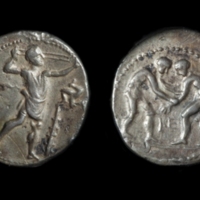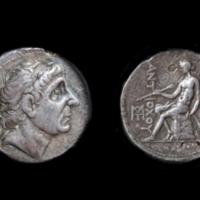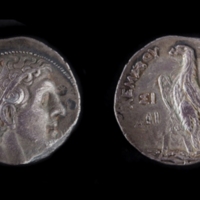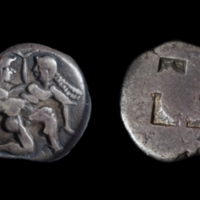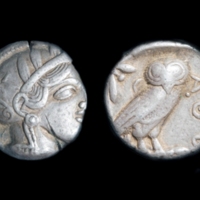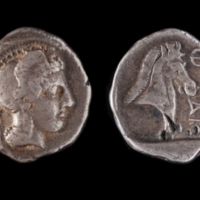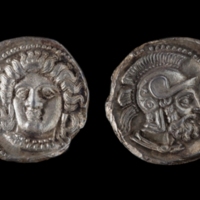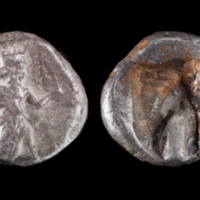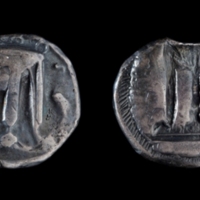Ancient Coins at the Hallie Ford Museum of Art
Dublin Core
Title
Ancient Coins at the Hallie Ford Museum of Art
Subject
The entire collection of coins found at Hallie Ford Museum of Arts.
Description
A guide to the ancient coins collection at the Hallie Ford Museum of Art.
Source
Gifts of James and Aneta McIntyre
Information about the coins was found in these resources:
Cohen, Henry, René Cagnat, and James C. Egbert. Latin Epigraphy II: The Coin Inscriptions and Epigraphical Abbreviations of Imperial Rome. Chicago: Ares, 1978. Print.
Hannestad, Niels. Roman Art and Imperial Policy. Århus C [Denmark: Aarhus UP, 1988. Print.
Klawans, Zander H. An Outline of Ancient Greek Coins. Racine, WI: Whitman Pub., 1959. Print.
Knorr, Ortwin. "Catalogue of the McIntyre Collection of Greek and Roman Coins." Classics: Ancient Coins in the HFMA. Willamette University, Hallie Ford Museum of Art, n.d. Web. 05 Aug. 2013. <http://www.willamette.edu/cla/classics/resources/hfma/coins.html>.
Sayles, Wayne G. Ancient Coin Collecting II: Numismatic Art of the Greek World. Iola, WI: Krause Publications, 1997. Print.
Sayles, Wayne G. Ancient Coin Collecting III: The Roman World-politics and Propaganda. Iola, WI: Krause Publications, 1997. Print.
Sear, David R. Roman Coins and Their Values: The Millennium Edition. London: Spink, 2000. Print.
Whitting, Philip D. Byzantine Coins. New York: Putnam, 1973. Print.
Information about the coins was found in these resources:
Cohen, Henry, René Cagnat, and James C. Egbert. Latin Epigraphy II: The Coin Inscriptions and Epigraphical Abbreviations of Imperial Rome. Chicago: Ares, 1978. Print.
Hannestad, Niels. Roman Art and Imperial Policy. Århus C [Denmark: Aarhus UP, 1988. Print.
Klawans, Zander H. An Outline of Ancient Greek Coins. Racine, WI: Whitman Pub., 1959. Print.
Knorr, Ortwin. "Catalogue of the McIntyre Collection of Greek and Roman Coins." Classics: Ancient Coins in the HFMA. Willamette University, Hallie Ford Museum of Art, n.d. Web. 05 Aug. 2013. <http://www.willamette.edu/cla/classics/resources/hfma/coins.html>.
Sayles, Wayne G. Ancient Coin Collecting II: Numismatic Art of the Greek World. Iola, WI: Krause Publications, 1997. Print.
Sayles, Wayne G. Ancient Coin Collecting III: The Roman World-politics and Propaganda. Iola, WI: Krause Publications, 1997. Print.
Sear, David R. Roman Coins and Their Values: The Millennium Edition. London: Spink, 2000. Print.
Whitting, Philip D. Byzantine Coins. New York: Putnam, 1973. Print.
Date
Early Greek- Medieval
Rights
Hallie Ford Museum of Art
Type
Ancient Coins
Coverage
A selection of these coins are on view in the Mark and Janeth Sponenburgh Gallery at Hallie Ford Museum of Art.
Collection Items
Aspendos, Pamphylia Stater.
Aspendos in Pamphylia was a Greek colony founded by the Argives on the modern-day southern coast of Turkey. In the fifth century BCE, the city began minting coins according to the Persian standard - a different weight system that determined the value…
Antiochus II, Silver Tetradrachm.
Antiochus II inherited the throne from his father, Antiochus I, when the Seleucid Empire was in the throes of defeat. Pergamum, the victor, was a burgeoning kingdom that would grow over the next hundred years at the expense of the Seleucids. This…
Ptolemy II Philadelphos, Silver Tetradrachm
Ptolemy II Philadelphos was the first of the Ptolemy’s to adopt the title of Pharaoh. This was not the only custom he acquired from the Egyptians as he also married his sister, a practice that was usually taboo among the Greeks. Similar to what…
Thasos, Silver Stater
The island of Thasos, just off the coast of Thrace in the north Aegean Sea, was a cultic center for the worship of Dionysus. This motif is a common one for northern Greece, an area famed for its wine.
The variations of this style include some…
The variations of this style include some…
Alexander III (the Great) of Macedon, Gold Stater
Alexander III of Macedon is more commonly known as Alexander the Great. A powerful and very successful military leader, Alexander’s gold coinage is symbolic of his kingship over a unified Greek state against the Persian barbarians.
The helmeted…
The helmeted…
Athens, Silver Tetradrachm
The Athenian “owl” is one of the most recognizable coins of the ancient world. First minted in 515 BCE, the “owl,” featuring Athena on the obverse and, her symbol, the owl, on the reverse, was continually minted by the Athenians until they gave up…
Pharsalos, Thessaly, Silver Hemidrachm
Though never mentioned in Homeric epic, Thessaly claimed its founder was none other than Aiakos, the grandfather of Achilles, making it the Homeric Phthia, also the birthplace of Achilles.
Later in time, probably around 60 CE, Thessaly was…
Later in time, probably around 60 CE, Thessaly was…
Tarsus, Cilicia, Silver Stater
Damates (ca. 407 - 362 BCE) was the satrap (Persian governor) of both Cappadocia and Cicilia under the Persian Great King Artaxerxes II (405-359 BCE). Proving his worth through many bloody battles, Damates became the most powerful satrap of…
Achaemenid, Silver Siglos
This coin was minted during the time of one of the most famous attempts at Persian expansion, around the beginning of the fifth century BCE. The Battle of Marathon, where Darius I attempted to gain control of mainland Greece, is one of the most…
Croton, Bruttium, Silver Stater
Croton was founded as an Achaean colony in 710 BCE. Croton was a very prosperous Greek colony: boasting many Olympic victors, the famous wrestler Milon, the school of Pythagoras (opened in 530 BCE), and, according to Herodotus (3.131), some of the…
